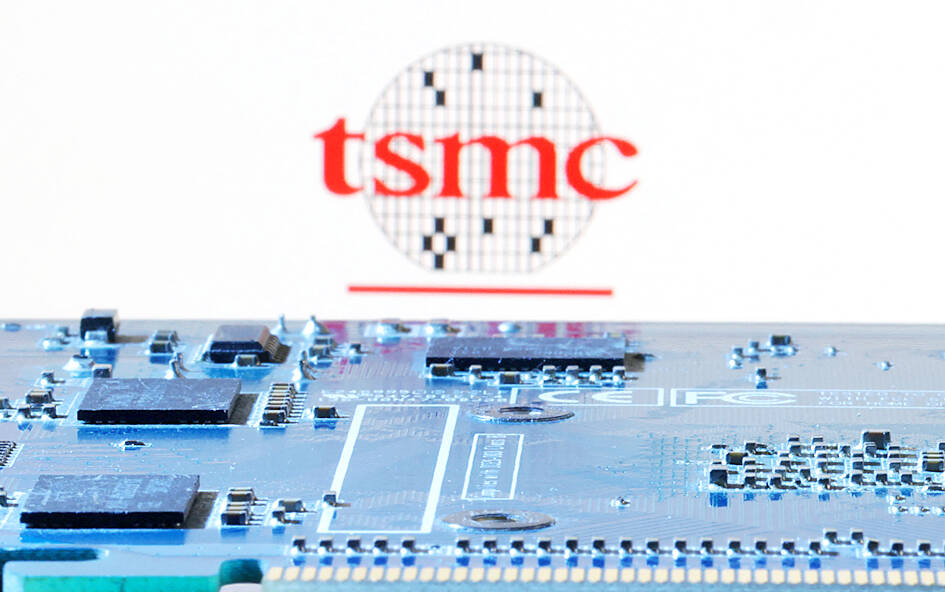Taiwan Semiconductor Manufacturing Co (TSMC, 台積電) said yesterday it was still considering venue options for its new advanced wafer fab, contrary to a local media report earlier in the day that the chipmaker was planning to build a 1-nanometer wafer plant in Chiayi County.
While the world’s largest contract chipmaker did not directly comment on the matter of Chiayi as a potential location, TSMC said in a statement that the company would need to consider all factors before making a final decision on where to build the 1-nanometer fab.
The Chinese-language Economic Daily News cited unnamed sources as saying that TSMC had submitted an application to the authorities supervising the Chiayi section of the Southern Taiwan Science Park (南部科學園區) for 100 hectares of land so it could expand operations.

Photo: Dado Ruvic, Reuters
The report said TSMC was expected to use 60 of the 100-hectare parcel to build a 1-nanometer fab, while the remaining 40 hectares were to be used to set up an advanced IC packaging and testing plant to provide a one-stop service for its clients.
It is estimated that TSMC would spend more than NT$1 trillion (US$31.89 billion) in its 1-nanometer process development, the report said.
In the statement, TSMC said that Taiwan is the hub for the chipmaker’s worldwide expansion.
TSMC added that it was not ruling out any potential venue and that it would continue working with science park authorities to choose a location for the investment.
However, the chipmaker did not specify whether the authorities it was in discussions with were the Southern Taiwan Science Park, the Central Taiwan Science Park (中部科學園區) or the Hsinchu Science Park (新竹科學園區).
Last month, Taichung Mayor Lu Shiow-yen (盧秀燕) told a Taichung City Council hearing that TSMC would build a fab in the second phase of Central Taiwan Science Park expansion that would use more advanced technology than the 2-nanometer process.
TSMC is building a 2-nanometer fab in Hsinchu County’s Baoshan Township (寶山) with commercial production scheduled to start next year. The 2-nanometer production is to be expanded to Kaohsiung with two fabs planned.
Last week, TSMC said it was evaluating the possibility of building a third 2-nanometer process fab in Kaohsiung following strong demand.

JITTERS: Nexperia has a 20 percent market share for chips powering simpler features such as window controls, and changing supply chains could take years European carmakers are looking into ways to scratch components made with parts from China, spooked by deepening geopolitical spats playing out through chipmaker Nexperia BV and Beijing’s export controls on rare earths. To protect operations from trade ructions, several automakers are pushing major suppliers to find permanent alternatives to Chinese semiconductors, people familiar with the matter said. The industry is considering broader changes to its supply chain to adapt to shifting geopolitics, Europe’s main suppliers lobby CLEPA head Matthias Zink said. “We had some indications already — questions like: ‘How can you supply me without this dependency on China?’” Zink, who also

The number of Taiwanese working in the US rose to a record high of 137,000 last year, driven largely by Taiwan Semiconductor Manufacturing Co’s (TSMC, 台積電) rapid overseas expansion, according to government data released yesterday. A total of 666,000 Taiwanese nationals were employed abroad last year, an increase of 45,000 from 2023 and the highest level since the COVID-19 pandemic, data from the Directorate-General of Budget, Accounting and Statistics (DGBAS) showed. Overseas employment had steadily increased between 2009 and 2019, peaking at 739,000, before plunging to 319,000 in 2021 amid US-China trade tensions, global supply chain shifts, reshoring by Taiwanese companies and

Taiwan Semiconductor Manufacturing Co (TSMC, 台積電) received about NT$147 billion (US$4.71 billion) in subsidies from the US, Japanese, German and Chinese governments over the past two years for its global expansion. Financial data compiled by the world’s largest contract chipmaker showed the company secured NT$4.77 billion in subsidies from the governments in the third quarter, bringing the total for the first three quarters of the year to about NT$71.9 billion. Along with the NT$75.16 billion in financial aid TSMC received last year, the chipmaker obtained NT$147 billion in subsidies in almost two years, the data showed. The subsidies received by its subsidiaries —

At least US$50 million for the freedom of an Emirati sheikh: That is the king’s ransom paid two weeks ago to militants linked to al-Qaeda who are pushing to topple the Malian government and impose Islamic law. Alongside a crippling fuel blockade, the Group for the Support of Islam and Muslims (JNIM) has made kidnapping wealthy foreigners for a ransom a pillar of its strategy of “economic jihad.” Its goal: Oust the junta, which has struggled to contain Mali’s decade-long insurgency since taking power following back-to-back coups in 2020 and 2021, by scaring away investors and paralyzing the west African country’s economy.